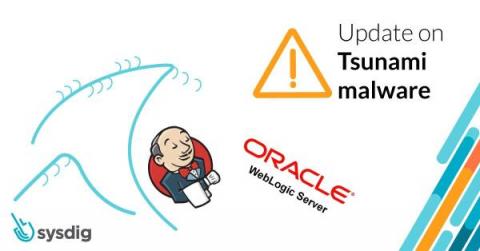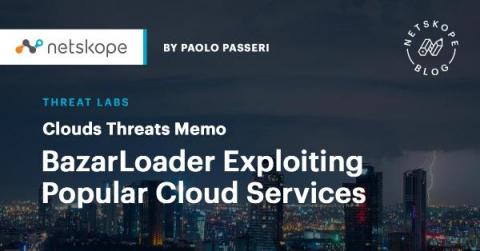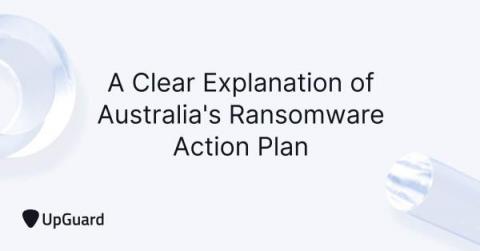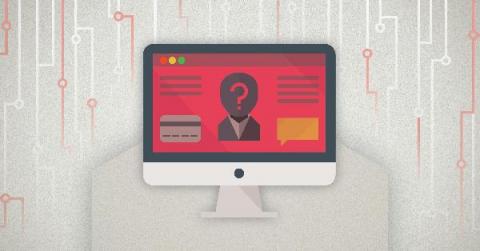Security | Threat Detection | Cyberattacks | DevSecOps | Compliance
Malware
[CompTIA ISAO & SecurityScorecard Partnership] 2 Key Business Essentials to Build Cyber Resilience
Viruses are the hot topic of 2021. We’re not just talking about the COVID-19 virus. Computer viruses, identity theft, and threat actors are no longer just the subject of sci-fi films and crime shows, but a reality of running a business. More than ever, cybersecurity is top of mind for business leaders. Whether you are a Fortune-500 Company or just launching your first venture, no business is too big or too small to escape the realities of today’s cyber threats.
Threat news: Tsunami malware mutated. Now targeting Jenkins and Weblogic services
The Tsunami malware is back! Although it appeared for the first time several years ago, the Sysdig Research Team has just discovered a new sample of Tsunami malware targeting Jenkins and Weblogic services deployed in Kubernetes clusters. The Tsunami malware is a backdoor that gives the attackers full control over the infected systems. Indeed the targeted machines, once infected, communicate with an IRC server waiting for new commands to be executed.
Cloud Threats Memo: BazarLoader Exploiting Popular Cloud Services
BazarLoader (sometimes referred to as BazaLoader) is a popular downloader among criminals, used to distribute multiple malicious payloads including Ryuk and Conti ransomware. According to a recent report by Phishlabs, during Q3 2021 this malware accounted for 24.7% of all attacks, earning the unwelcome accolade of being the most common payload.
In Times of Ransom(every)ware, Unified Security is Essential
Following a series of headline-grabbing ransomware attacks that disrupted critical services in the US, FBI Director Christopher Wray likened the threat posed by ransomware to the September 11 terrorist attacks of 2001. According to Wray, recent attacks against one of the largest oil pipeline operators in the United States and a major meat processing operation may be just a harbinger of what is to come.
DBatLoader: Abusing Discord to Deliver Warzone RAT
67% of the malware downloads Netskope blocks come from popular cloud applications being abused by attackers. One of the services commonly abused by threat actors is Discord, which is abused to host malware such as TroubleGrabber using public attachment URLs. In this blog post, we will analyze a recent DBatLoader (a.k.a. ModiLoader) sample that uses this technique on Discord to deliver a malware known as Warzone (a.k.a. Ave Maria), a Remote Access Trojan created in 2018.
A Clear Explanation of Australia's Ransomware Action Plan
During a ransomware attack, a victims vital internal processes are seized and encrypted, completely forcing their business offline. These crippling actions are only reversed if a ransom payment is made. Ransomware attacks are an escalating threat to global security and the Australian Government is taking a firm stance against it. With global ransomware damage costs predicted to reach $20 billion and increasing cyberattack complexity, this isn't a fight a single country can win alone.
US Government warns of BlackMatter ransomware attacks against critical infrastructure
The US Government has issued an alert to organisations about the threat posed by the BlackMatter ransomware group. The government’s Cybersecurity & Infrastructure Security Agency (better known as CISA) issued the advisory earlier this week, following a series of BlackMatter ransomware attacks since July 2021 targeting US critical infrastructure, including two American organisations working in the food and agriculture sector.
Malware Dropped Through Google Ads Targeting Banks
Banks continue to be a top target for cyber criminals. As we indicated in our blogpost on the risks to financial services networks, in 2020 alone there were more than 1,500 cyberattacks on banks, and in recent months, we’ve seen incidents such as the cyberattack on the New Zealand Federal Reserve and against the largest bank in Ecuador. Now, a new threat has emerged, and the main targets are Australian and German banks.
What is Ransomware and How Do You Remove It?
Someone in your organization gets an email with an attached document. The sender seems legitimate, but when they click on the link, it’s not what it claims to be. Soon your organization’s data is encrypted and you receive a message: pay a ransom to the attackers if you want the decryption key. You’ve just been the victim of a ransomware attack. Ransomware has become a major attack vector in 2021.











